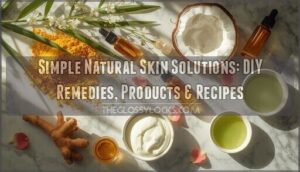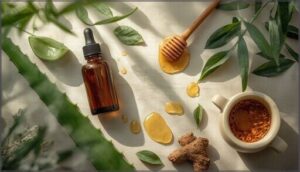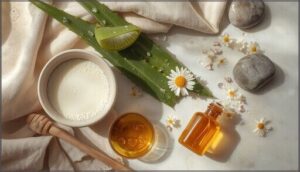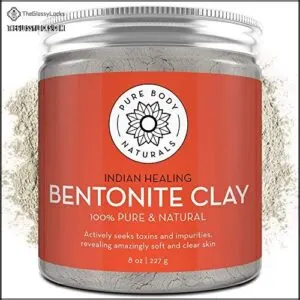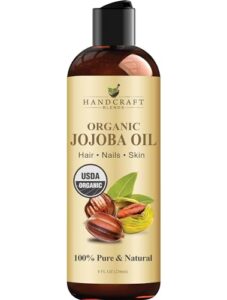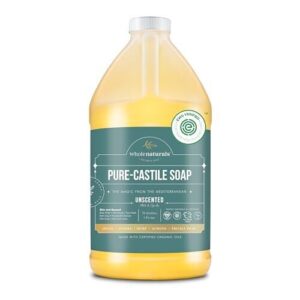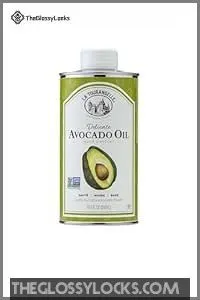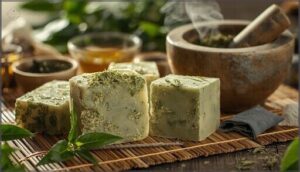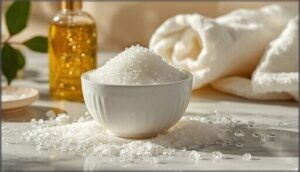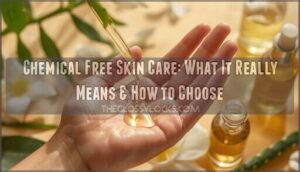This site is supported by our readers. We may earn a commission, at no cost to you, if you purchase through links.
Your skin throws tantrums for reasons that might surprise you—stress hormones can trigger breakouts just as fast as a greasy burger, and the pollution clinging to your face each day quietly speeds up wrinkles. You’ve probably noticed that expensive serums don’t always deliver what they promise, while your grandmother’s kitchen remedies somehow get results.
The truth is, simple natural skin solutions often work because they align with how your skin actually functions: tea tree oil reduces acne lesions by 40%, coconut oil boosts moisture levels by 30%, and turmeric can slash melanin production by up to 80%.
Understanding what’s triggering your specific skin concerns—whether it’s environmental damage, hormonal shifts, or barrier dysfunction—lets you match the right natural ingredients to your needs without the guesswork or chemical cocktails.
Table Of Contents
Key Takeaways
- Your skin responds to stress hormones, pollution, and diet just as powerfully as it does to topical products, so managing internal triggers like high-glycemic foods and cortisol levels directly improves breakouts, hydration, and aging signs.
- Natural ingredients like tea tree oil, colloidal oatmeal, and turmeric deliver measurable results—reducing acne lesions by 40%, boosting moisture by 30%, and cutting melanin production by up to 80%—often matching or surpassing synthetic alternatives without harsh side effects.
- Most natural remedies require 4–8 weeks of consistent use before you’ll see visible improvement, whether you’re targeting acne, dryness, or hyperpigmentation, so patience and tracking changes matter more than switching products constantly.
- Simple kitchen staples like honey, coconut oil, and green tea work because they align with your skin’s natural functions—strengthening the barrier, reducing inflammation, and delivering antioxidants—making expensive serums less necessary when you match the right ingredient to your specific concern.
Common Causes of Skin Issues
Your skin reacts to what’s happening both around you and inside you. Breakouts, dryness, and discoloration don’t appear out of nowhere—they’re your body’s way of signaling that something needs attention.
Your skin’s breakouts and dryness are signals that something inside or around you needs attention
Let’s look at three major factors that influence your skin’s health and appearance.
Environmental and Lifestyle Triggers
While you’re taking steps to care for your skin, everyday environmental and lifestyle factors may be working against you. Air pollution doesn’t just cloud your view—it accelerates skin aging and can increase pigment spots by approximately 20%. Air pollution can also contribute to various skin conditions through oxidative stress.
Protecting your skin means understanding these hidden triggers:
- UV exposure causes 65–90% of all skin cancers and drives premature aging
- Tobacco smoke damages collagen fibers, creating deeper wrinkles and a leathery appearance
- Sleep patterns directly affect your skin barrier function and hydration levels
- Psychological stress worsens inflammation and flares conditions like acne and eczema
Your skin’s health reflects your environment and daily habits, making skin protection with antioxidants essential for preventing skin damage and reducing skin inflammation.
Hormonal Imbalances and Stress
Your hormones and stress levels quietly influence skin health every day. In women with PCOS, acne affects around 42%—driven by androgen levels that increase sebum and slow cell turnover.
Psychological stress triggers cortisol release, raising TEWL and weakening your skin barrier. Even one night of sleep deprivation reduces hydration and worsens skin inflammation and irritation, making natural remedies essential for restoring balance. This can be attributed to higher androgen levels in the body.
Diet and Its Impact on Skin Health
What you eat shapes your skin more than you might think. High glycemic loads—around 175 daily versus 122 in clear-skin individuals—and milk or ice cream nearly quadruple acne risk. Meanwhile, Mediterranean diets rich in antioxidants and omega-3s reduce inflammation through the gut-skin axis, improving hydration and elasticity. Balanced dietary patterns delivering natural ingredients support skin nourishment and barrier strength.
- Reduce high-glycemic inflammatory foods
- Increase antioxidant intake from colorful produce
- Choose Mediterranean dietary patterns
- Support gut-skin axis with probiotics
- Prioritize hydration effects and whole foods
Natural Remedies for Acne-Prone Skin
If you’re dealing with acne, you don’t always need harsh chemicals to see improvement. Natural ingredients with antibacterial and anti-inflammatory properties can help calm breakouts while supporting your skin’s healing process.
Here are five gentle remedies you can try at home to address acne-prone skin.
Tea Tree Oil Spot Treatment
You’ve probably heard about tea tree oil as a natural acne treatment, and there’s solid science behind it. A 5% tea tree oil concentration applied directly to blemishes twice daily can reduce lesion counts by roughly 40% over 45 days—clinical trials show it works similarly to benzoyl peroxide.
The antibacterial and anti-inflammatory properties target acne-causing bacteria effectively. Just dilute it properly to avoid adverse reactions like dryness.
Apple Cider Vinegar Balancing Toner
Apple cider vinegar as a skin toner sounds promising, but the reality is more complicated. While it contains acetic acid that could theoretically help with skin pH balance and acne, ACV dilution is critical—undiluted versions can cause chemical burns.
Studies show that even 0.5% solutions caused irritation in over 70% of users, with minimal long-term effects on barrier function or acne bacteria. Toner application methods matter, but irritation potential remains high.
Honey and Cinnamon Soothing Mask
A honey and cinnamon mask offers antibacterial and anti-inflammatory benefits, but you need to understand the trade-offs. In vitro studies confirm both ingredients fight acne bacteria, yet clinical evidence for DIY face masks remains limited.
Key considerations before applying:
- Medical-grade honey types are safer than raw varieties due to controlled impurities
- Cinnamon allergy can trigger contact dermatitis, requiring patch-testing first
- Mask benefits vary—only 7.5% showed additional improvement in one trial
Dilution and short contact time reduce skin inflammation risks.
Aloe Vera Gel for Acne Healing
When acne flares up, aloe vera gel’s antibacterial properties can reduce inflammation and support healing. Clinical trials show combination acne therapies using aloe with tretinoin lower lesion counts more effectively than tretinoin alone. These enhanced topical agents also improve post-acne wound repair.
However, around 0.1–1% of people experience adverse skin reactions like contact dermatitis, so patch-test first.
Green Tea Anti-Inflammatory Compress
Green tea’s catechins work like tiny firefighters, dousing inflammation in angry, acne-prone skin. Brew two green tea bags in hot water, let cool, then soak a clean cloth in the liquid. Press the compress gently against inflamed areas for 5–10 minutes daily. This DIY beauty solution can:
- Reduce inflammatory acne lesions
- Lower sebum production
- Calm UV-induced erythema
- Support skin barrier function
- Deliver antioxidants directly to your complexion
Topical green tea bags generally suit most skin types and show favorable compress safety in clinical studies, though you should patch-test first if you have contact allergies. The antiinflammatory properties target skin inflammation reduction at multiple levels, making this one of the simplest skin care remedies you can prepare at home. Apply your compress 3–5 times weekly for best results, and watch redness and breakouts settle down over 4–8 weeks.
Gentle Solutions for Dry and Sensitive Skin
Dry and sensitive skin can feel like a constant battle, but natural remedies offer gentle relief without harsh chemicals. The key is finding ingredients that calm inflammation, lock in moisture, and strengthen your skin’s protective barrier.
Here are five simple solutions that work with your skin, not against it.
Colloidal Oatmeal Calming Soak
When your skin feels like it’s been through the wringer, a colloidal oatmeal soak can be your reset button. This finely ground powder disperses in lukewarm bathwater, wrapping irritated skin in a protective layer that calms eczema flare-ups and boosts hydration.
Soak for 10–15 minutes, pat dry gently, then lock in moisture immediately—your skin barrier will thank you.
Coconut Oil Deep Moisturizer
If your skin barrier feels stripped and tight, coconut oil might be your deep-dive solution. Clinical trials show twice-daily application improves hydration measurably—skin moisture levels jump by about 30% in weeks.
Use it on body areas prone to dryness, applying a thin layer after bathing while skin’s still damp. Just skip your face if you’re acne-prone—coconut oil’s comedogenic rating of 4 means it clogs pores easily.
Shea Butter Protective Barrier
Beyond simple moisturizing, shea butter excels at lipid barrier repair. Clinical data show it’s as effective as ceramide products for eczema symptom relief.
Rich in fatty acids and antioxidant skin protection compounds, this natural ingredient restores skin hydration levels while defending against UV damage.
Apply a pea-sized amount to damp skin barrier areas twice daily for sustained dry skin relief.
Cucumber and Honey Hydration Mask
When you need fast relief from dehydration, this simple cucumber and honey hydration mask delivers. Cucumber’s 95% water content combined with honey’s humectant properties forms a protective film that locks in moisture.
Blend half a cucumber with two tablespoons of raw honey, apply for 15 minutes, and rinse. This DIY skincare recipe works beautifully on all skin types, especially during winter months.
Olive Oil Nourishing Treatment
Your skin drinks in extra virgin olive oil’s antioxidant-rich polyphenols and vitamin E—compounds that boost hydration and calm redness. But here’s the catch: oleic acid risks disrupting your skin barrier with repeated use, especially if you’re prone to eczema.
Think of olive oil as an occasional nourishing treatment rather than your daily moisturizer, and always patch-test first.
Brightening and Evening Skin Tone Naturally
Dark spots and uneven tone can stick around long after a breakup with acne or sun damage. Your skin naturally sheds and renews itself, but certain ingredients can help speed up that process and lighten areas of hyperpigmentation.
The following remedies work by gently inhibiting melanin production or exfoliating the outer layer where pigment sits.
Licorice Root Extract for Dark Spots
When hyperpigmentation dims your glow, licorice root extract offers a research-backed brightening path. Glabridin benefits include inhibiting melanin production at the cellular level, making it effective for melasma treatment and dark circle remedies. Studies show 4% extract concentrations reduced pigmentation in 80% of users after consistent use.
- Apply licorice-based serum twice daily to clean skin
- Pair with broad-spectrum sun protection to prevent darkening
- Look for formulations containing 2-5% extract concentrations
- Expect visible improvements in dark spots after 8-12 weeks
- Combine with vitamin C for enhanced skin brightening results
This natural skin treatment works best with patience and diligent formulation safety—your skin’s brightening journey requires both smart ingredients and consistent hyperpigmentation treatment habits.
Papaya Enzyme Exfoliation
When surface dullness makes your complexion look tired, papaya enzyme exfoliation offers a gentle skin brightening solution. Papain breaks down dead skin cells without harsh scrubbing, improving texture while reducing dark spots through its anti-aging effects.
Apply 1-5% papaya formulations once or twice weekly—this natural exfoliation technique delivers visible smoothing after four weeks. Patch-test first, as this natural ingredient can trigger reactions in latex-sensitive individuals.
Potato Juice for Pigmentation
Potato juice for pigmentation remains a popular home remedy, yet clinical evidence doesn’t support catecholase efficacy from raw applications. While exosome research using purified Solanum tuberosum extracts shows promise for hyperpigmentation, DIY skincare recipes lack those actives. If you choose this natural skin treatment, consider application safety concerns:
- Patch-test for allergic reactions first
- Never combine with lemon without medical guidance
- Expect no measured melanin reduction
- Watch for irritation or redness
- Recognize standardized products offer better results
Turmeric and Lemon Brightening Paste
In vitro studies show turmeric’s curcumin reduces melanin synthesis by 30–80%, yet DIY skincare recipes pose real risks. Lemon juice contains 5–8% citric acid for exfoliation, but undiluted applications trigger phototoxicity risks and paradoxical hyperpigmentation after sun exposure.
Turmeric’s yellow pigment creates staining potential on lighter skin tones. While formulation methods combining small amounts with milk or flour improve safety, sensitivity concerns and limited efficacy evidence make professionally formulated products wiser choices for evening skin tone.
Top 5 Simple Natural Skin Products
You don’t need a cabinet full of complicated products to support healthy skin. A few high-quality natural ingredients can work as the foundation for almost any skincare routine you want to create at home.
These five staples are adaptable, easy to find, and backed by solid evidence for skin health.
1. Bentonite Clay Powder Face And Body
You might think of bentonite clay as nature’s vacuum cleaner for your skin—it pulls excess oil and impurities from deep within your pores. This Wyoming-sourced clay absorbs up to seven times its weight in water, making it remarkably effective for detoxifying properties and skin cleansing.
To use it, mix the powder with water until you get a smooth paste, apply to your face or body, and leave it on for 15–20 minutes before rinsing. It’s especially helpful for oily and acne-prone skin types, though you should always patch-test first to avoid potential irritation.
Best For: People with oily or acne-prone skin who want a natural, budget-friendly way to deep-clean pores and control excess sebum.
- Absorbs up to seven times its weight in water, making it exceptionally effective at drawing out oils and impurities from congested pores
- Pure Wyoming bentonite with no parabens, phthalates, or harsh chemicals—just straight volcanic ash clay
- Versatile enough to use as a face mask, hair treatment, underarm detox, or full-body clay wrap
- Can be tricky to mix smoothly and tends to clump if you don’t add water gradually
- May cause redness, burning, or irritation on sensitive skin, so a patch test is essential before full application
- Some bentonite clay products have tested positive for heavy metals like lead, so third-party testing and quality verification matter
2. Organic Cacao Powder Rich Dark Chocolate
You’ve probably enjoyed cocoa powder in desserts without realizing it doubles as a skin-saving ingredient. This organic cacao powder delivers potent antioxidants that protect your skin from environmental damage and support collagen production.
Research shows daily cacao intake can boost facial moisture by about 4.5% over 12 weeks and visibly reduce periorbital wrinkles. Mix it into DIY skincare recipes for anti-inflammatory effects, or create a simple face mask by combining it with honey.
Just remember—stick to moderate portions if you’re concerned about acne considerations or heavy metal safety.
Best For: Anyone looking to boost skin hydration and reduce wrinkles naturally while enjoying a versatile, organic ingredient for smoothies, baking, and DIY face masks.
- Clinically shown to increase facial moisture by 4.5% and reduce periorbital wrinkles over 12 weeks with daily use
- Packed with antioxidants and flavonoids that protect skin from oxidative stress and support collagen production
- USDA organic, non-GMO, and diet-friendly (keto, paleo, vegan) with no added sugar or artificial ingredients
- Naturally bitter flavor requires pairing with sweeteners or other ingredients to taste good
- Produced in a facility with common allergens (peanuts, tree nuts, milk, soy), which may concern those with severe allergies
- Some dark chocolate and cacao products contain elevated lead and cadmium levels, so moderation is important for regular consumers
3. Handcraft Blends Organic Jojoba Oil
Your skin produces an oil called sebum that keeps it balanced, and jojoba oil mimics it almost perfectly. This cold-pressed extraction delivers impressive jojoba oil benefits—reducing water loss by 25% while strengthening your skin barrier function. Unlike heavier oils, it won’t clog pores and actually signals your sebum production to calm down when you’re too oily.
With market demand for natural ingredients skyrocketing, this organic option works beautifully in DIY skincare recipes for skin hydration and moisturizing without harsh chemicals.
Best For: Anyone looking for a lightweight, natural moisturizer that works on all skin types—especially if you’ve got oily or acne-prone skin and want something that won’t clog pores.
- Mimics your skin’s natural sebum and cuts water loss by 25%, so it hydrates without feeling greasy or heavy
- USDA Organic, cold-pressed, and hexane-free—you’re getting pure jojoba oil with no fillers or sketchy chemicals
- Works everywhere—face, hair, nails, even as a carrier oil for DIY blends—and has a non-comedogenic rating of zero
- The scent can be off-putting for some people—it’s unrefined, so it smells earthy and nutty, not like a spa product
- The dispenser top tends to leak a bit of residual oil, which can get messy if you’re not careful
- It’s not a miracle worker for everyone—some skin types just don’t vibe with it, despite the generally high tolerance
4. Whole Naturals Pure Castile Soap Liquid
You’ll appreciate how Whole Naturals Pure Castile Soap Liquid takes ingredient transparency seriously—this concentrated formula blends organic prickly pear, argan, jojoba, and coconut oils without synthetic thickeners or fragrances.
Castile soap benefits shine through its many uses: use it as a body wash, shampoo, or even household cleaner, making it perfect for homemade skincare routines.
The eco-friendly impact matters too—it’s biodegradable and 2-3 times more concentrated than regular natural cleansers.
User feedback consistently praises its gentle cleansing for sensitive, eczema-prone, and acne-prone skin without disrupting your skin’s natural barrier.
Best For: People with sensitive skin or conditions like eczema and psoriasis who want a versatile, eco-friendly soap that works for everything from body wash to household cleaning.
- Made with organic plant-based oils and no synthetic additives, making it safe for sensitive skin and various skin conditions
- Extremely versatile—works as body wash, shampoo, laundry detergent, pet wash, and household cleaner
- 2-3 times more concentrated than regular soaps, so it lasts longer and reduces packaging waste
- Some users report the unscented version has an unpleasant natural smell
- May leave white smears or residue when it dries
- Requires dilution for many uses, which adds an extra step
5. La Tourangelle Avocado Oil Buttery Flavor
Beyond the sink, La Tourangelle Avocado Oil doubles as a skin treatment—its 60–70% oleic acid content makes it one of the most effective natural ingredients for hydration and barrier repair.
Clinical studies show topical avocado oil increases stratum corneum moisture within four weeks, while its anti-inflammatory phytosterols calm redness in eczema and psoriasis.
You can apply it directly to damp skin for wound healing benefits, or mix it into DIY scrubs for gentle moisturizing without clogging pores—a multipurpose solution for dry skin.
Best For: Anyone looking for a multi-purpose oil that works in the kitchen and as a natural moisturizer for dry or sensitive skin.
- Clinical studies show it genuinely improves skin hydration and barrier function within a few weeks of regular use.
- High smoke point and buttery flavor make it versatile for everything from salad dressings to high-heat cooking.
- Rich in omega-3s and antioxidants like vitamin E, offering both culinary and skincare benefits in one product.
- Pricier than standard cooking oils, so it might not make sense for everyday heavy cooking or deep frying.
- The distinct avocado taste won’t work for every recipe—some dishes need a more neutral oil.
- Some customers have reported receiving dented containers, which could affect the product’s shelf life.
DIY Skincare Recipes and At-Home Treatments
You don’t need a complicated routine or expensive products to see real results. With a few simple ingredients from your kitchen, you can create effective treatments that support your skin’s natural barrier and address common concerns.
Here are five easy recipes to get you started on your at-home skincare journey.
Homemade Green Tea Soap Scrub Bars
With green tea bags steeped in antioxidant-rich EGCG, you can craft gentle soap scrub bars at home using natural ingredients.
Here’s what makes them effective DIY beauty solutions:
- Green tea delivers photoprotection by reducing UV-induced inflammation
- Skin pH around 5.0–5.5 maintains your skin’s protective barrier
- Fine exfoliation parameters prevent irritation while smoothing texture
- Formulation tips: add heat-sensitive ingredients below 40°C to preserve EGCG stability
These homemade skincare recipes balance cleansing with barrier protection.
Oatmeal Body Butter for Soothing Skin
You’ll love blending colloidal oatmeal into a rich body butter base for eczema relief and soothing dry skin. Combining 50–60% shea or cocoa butter with natural ingredients like jojoba oil creates an occlusive barrier that locks in hydration.
This formulation restores skin barrier function, offering serious skin moisturizing power for persistent skin irritation. Oatmeal benefits your skin by reducing inflammation and itching.
Mocha Mud Mask for Detoxifying
Mixing coffee grounds with bentonite clay and cacao powder creates a detoxifying face mask that confronts oily skin head-on. Coffee benefits include antioxidant activity and improved microcirculation, while clay types like bentonite absorb excess sebum without stripping your skin barrier. Cacao effects improve hydration and reduce fine lines.
Apply this homemade skincare blend for 10 minutes, then rinse. Store unused portions refrigerated for up to three days, and always patch-test first for mask safety.
Banana Avocado Face Mask for Nourishment
For deep skin nourishment, you can mash ¼ avocado with ½ banana—a DIY mask rich in vitamins A, E, and potassium. These natural ingredients deliver a hydration boost while supporting your skin barrier.
- Use ripe, organic produce for ingredient sourcing
- Apply mask application tips: leave on 10–15 minutes
- Suitable for dry and normal skin type suitability
Rinse with lukewarm water to reveal softer, more radiant skin.
Sugar Face Scrub for Gentle Exfoliation
A gentle sugar face scrub removes dead skin cells while triggering surface renewal. Clinical data shows that mechanical exfoliation can shorten turnover from 28 days to roughly 20–25 days.
Mix 1 tablespoon granulated sugar with ½ tablespoon jojoba oil. Massage softly in circles for 30 seconds, then rinse.
Use once weekly on intact skin; avoid active acne or irritation to prevent micro-tears.
Frequently Asked Questions (FAQs)
How often should I change my pillowcase?
Change your pillowcase at least once weekly to prevent bacteria buildup.
If you have acne-prone or sensitive skin, switch it every two to three days to reduce oils and irritants that worsen breakouts.
Can stress actually cause wrinkles and aging?
Yes, chronic stress accelerates skin aging by elevating cortisol, which breaks down collagen and triggers oxidative stress. This leads to visible wrinkles, reduced skin elasticity, and telomere shortening—hallmarks of premature aging requiring antiaging skincare interventions.
Whats the best water temperature for washing?
For washing your face, the Goldilocks rule applies: lukewarm water around 90–104°F protects your skin barrier. Hot water strips natural oils, while cold water can irritate and reduce cleansing efficiency.
Do jade rollers really improve skin texture?
Facial rollers produce modest improvements in skin texture through lymphatic drainage and massage benefits that boost circulation. Studies show temporary puffiness reduction and slight elasticity gains, though consumer perception often outpaces documented texture changes in controlled research.
How long before natural remedies show results?
Think of natural skin treatments like planting seeds—you won’t see blooms overnight. Most acne improvement timelines and eczema relief duration span 4–8 weeks with consistent application, while brightening visible changes often require 2–3 months of your daily skin care routine.
Conclusion
Studies show 60% of skincare products contain at least one ingredient linked to irritation, yet simple natural skin solutions sitting in your pantry often deliver better results with zero side effects. Your skin doesn’t need a chemistry lab—it needs ingredients it recognizes.
Start with one remedy that targets your primary concern, give it three weeks, and track what changes. Real transformation happens when you stop guessing and start listening to what your skin actually needs.
- https://japsonline.com/abstract.php?article_id=3416&sts=2
- https://onlinelibrary.wiley.com/doi/abs/10.1111/jocd.16710
- https://goldmanlaboratories.com/blogs/blog/analysis-of-plant-based-collagen-clinical-trial-results-and-brand-performance
- https://www.statnews.com/sponsor/2020/06/05/clinical-trials-test-natural-skincare-with-the-same-rigor-as-synthetics/
- https://www.sciencedirect.com/science/article/abs/pii/S2210803321000221

